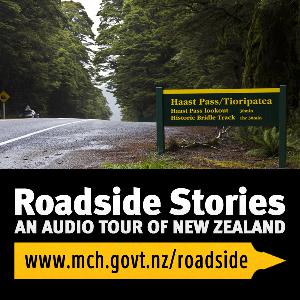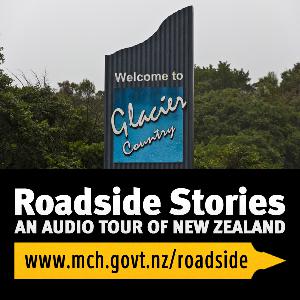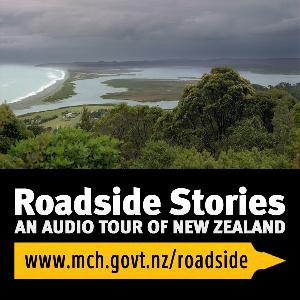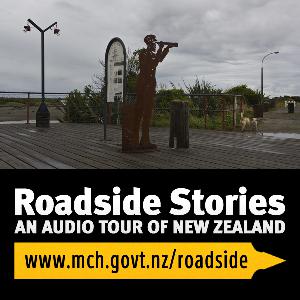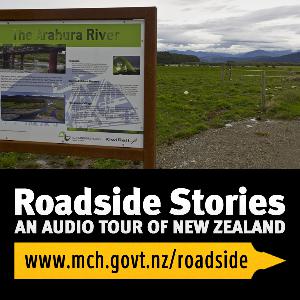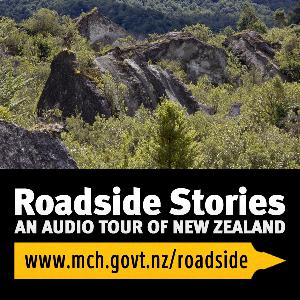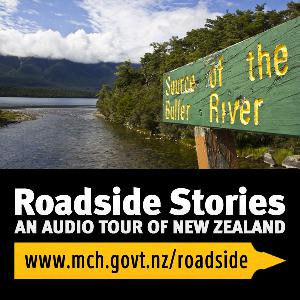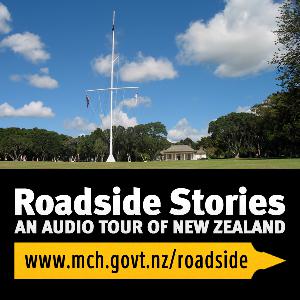Discover Roadside Stories
Roadside Stories

Roadside Stories
Author: Manatū Taonga - Ministry for Culture and Heritage (NZ)
Subscribed: 33Played: 276Subscribe
Share
© 2011 Ministry for Culture and Heritage
Description
Roadside Stories is a series of audio guides that follow major road trips in New Zealand. The stories cover the places you'll pass along the way - their people, their history, their cultural and natural significance. These stories are also available as an iPhone app and on YouTube - see http://www.mch.govt.nz/roadside for more information.
139 Episodes
Reverse
A spectacular biennial airshow, Warbirds over Wānaka showcases Second World War fighter aircraft and other unusual planes in the gorgeous surrounds of Wānaka. The show is the brainchild of aviator Tim Wallis, who pioneered live deer capture from helicopters in the 1960s and was dubbed 'Lord of the Choppers'. Archival audio sourced from Radio New Zealand Sound Archives, http://www.soundarchives.co.nz/. Sound files may not be reused without permission from Radio New Zealand Sound Archives (Reference number Spectrum 149).
Once a walking track used by Māori heading for West Coast reserves of pounamu (greenstone), Haast Pass was first crossed by Europeans during the 1860s gold rushes. Construction of a proper road began in the 1920s and 1930s depression, with unemployed workers wielding picks and shovels – but the road wasn't completed until the early 1960s.
The Franz Josef and Fox glaciers descend to unusually low altitudes, reaching into rainforest near the sea. In Māori tradition, Franz Josef is Kā Roimata o Hine Hukarere – the tears of Hine Hukarere, a young woman whose lover fell to his death there. Fox Glacier is the resting place of her lover, Tuawe. Archival audio sourced from Radio New Zealand Sound Archives, http://www.soundarchives.co.nz/. Sound files may not be reused without permission from Radio New Zealand Sound Archives (Reference number T6589).
New Zealand's largest unmodified wetland, Ōkarito Lagoon is home to a breeding colony of kōtuku (white herons). Long prized by Māori for their beauty and their white feathers, these graceful birds have been threatened by vandals, introduced predators and storms. Today their colony is protected. Archival audio sourced from Radio New Zealand Sound Archives, http://www.soundarchives.co.nz/. Sound files may not be reused without permission from Radio New Zealand Sound Archives (Reference number 147839).
Australian aviator Guy Menzies surprised Harihari locals when he completed the first solo trans-Tasman flight in 1931 by landing – unintentionally – in a flax swamp. Today Menzies' watery arrival spot is marked by a plaque. Archival audio sourced from Radio New Zealand Sound Archives, http://www.soundarchives.co.nz/. Sound files may not be reused without permission from Radio New Zealand Sound Archives (Reference number 32347).
After gold was discovered in 1864 a lively town sprang up at Hokitika. Within a few months it had 5,000 residents and 72 hotels. However, its port was dangerous, and many ships met their end on the bar at the river mouth. When the gold rush finished, Hokitika dwindled – though since 1990 its Wildfoods Festival has been popular with daring eaters.
Pounamu – greenstone or jade – was prized by Māori, and gave its name to the South Island (Te Wai Pounamu). Long associated with the Ngāi Tahu tribe, pounamu was especially common in the bed of the Arahura River. This precious stone is said to have been created by the taniwha Poutini. Archival audio sourced from Radio New Zealand Sound Archives, http://www.soundarchives.co.nz/. Sound files may not be reused without permission from Radio New Zealand Sound Archives (Reference number sa-d-02206-s02-pm).
West Coast coal has been mined since the 1860s, and coal was a vital source of energy in the 19th century. But coal mining is back-breaking work that can also be dangerous – 65 men died in the 1896 Brunner mine explosion, New Zealand's worst industrial disaster. In 2010, 29 workers died after an explosion at the Pike River coal mine. Archival audio sourced from Radio New Zealand Sound Archives, http://www.soundarchives.co.nz/. Sound files may not be reused without permission from Radio New Zealand Sound Archives (Reference number CDR742, Spectrum 865).
The famous Pancake Rocks at Punakaiki resemble a layered stack of pancakes, and caves beneath them open into blowholes which emit spectacular bursts of spray. The rocks are made of limestone – a sedimentary rock that is soluble in rainwater and often forms dramatic karst landscapes of caves, sinkholes and underground rivers.
Many settlers on the West Coast were Irish, and conflict sometimes erupted between Irish Catholics and Protestants. The worst confrontation was at the gold-rush tent town of Addisons Flat, where Protestants and Catholics fought in the streets in 1868.
Dramatic landslides, rock falls and waterfalls are the legacy of the two massive earthquakes that hit the Buller region in the 20th century. Lives were lost at Murchison in 1929, and again at Īnangahua in 1968. Archival audio sourced from Radio New Zealand Sound Archives, http://www.soundarchives.co.nz/. Sound files may not be reused without permission from Radio New Zealand Sound Archives (Reference number sa-d-01135-04-s01-s02-pm).
In late 1846, with his Māori guides Kehu and Pikewate, surveyor Thomas Brunner set off on an epic journey down the Buller River and to the West Coast. The group battled hunger, illness, injury and terrible weather, and it was 18 months before Brunner encountered another European. Archival audio sourced from Radio New Zealand Sound Archives, http://www.soundarchives.co.nz/. Sound files may not be reused without permission from Radio New Zealand Sound Archives (Reference number sa-d-02422-su01-s02-pm).
Northland was once covered in magnificent kauri forests – but almost all were logged after Europeans arrived in New Zealand. Felling the giant trees was dangerous work, and dams were built so the logs could be floated down rivers. Today a museum at Matakohe showcases the history of kauri forests and their exploitation. Archival audio sourced from Radio New Zealand Sound Archives, http://www.soundarchives.co.nz/. Sound files may not be reused without permission from Radio New Zealand Sound Archives (Reference number Spectrum 535).
In the late 19th century Auckland's main export was kauri gum. One rich source of the gum was the swampy land around Dargaville where kauri forests had been cleared. Gum-digging was tough work, often done by Dalmatian immigrants and by Māori. Today the Dargaville area is known for growing kūmara (sweet potato). Archival audio sourced from Radio New Zealand Sound Archives, http://www.soundarchives.co.nz/. Sound files may not be reused without permission from Radio New Zealand Sound Archives (Reference number 27604).
Waipoua Forest is the site of majestic giant kauri, including the towering 1,500-year-old Tāne Mahuta. Waipoua is one of New Zealand's few remnants of kauri forest – much of which was logged for timber in the 19th and 20th centuries. Archival audio: Archives New Zealand – Te Rua Mahara o te Kāwanatanga, http://www.archives.govt.nz/ Weekly Review 333. National Film Unit, 1948.
In 1955–56 a friendly dolphin known as Opo became a celebrity, drawing thousands of visitors to the sleepy town of Opononi on the Hokianga Harbour. Enjoying human company, Opo performed tricks and let children ride on her back. Archival audio: Archives New Zealand – Te Rua Mahara o te Kāwanatanga, http://www.archives.govt.nz/ Pictorial Parade 47. National Film Unit, 1956.
Hokianga Harbour was the departure point of legendary Māori navigator Kupe when he returned to his homeland of Hawaiki. Kupe is said to have left behind two taniwha (water spirits), which guided the safe landing of later Polynesian arrivals.
In the 1820s the Kerikeri mission station was under the protection of Hongi Hika and the Ngāpuhi tribe. Hongi had encouraged the establishment of the mission – largely because he wanted access to muskets, which gave Ngāpuhi a great military advantage over other tribes. Today the 1822 mission house is New Zealand's oldest building. Archival audio sourced from Radio New Zealand Sound Archives, http://www.soundarchives.co.nz/. Sound files may not be reused without permission from Radio New Zealand Sound Archives (Reference number T906).
The Treaty of Waitangi, considered to be New Zealand's founding document, was signed at Waitangi on 6 February 1840 between Māori chiefs and the British Crown. However, within five years Māori were at war with the British over land loss and treaty infringements. Since the 1970s the Waitangi Tribunal has investigated treaty breaches. Archival audio sourced from Radio New Zealand Sound Archives, http://www.soundarchives.co.nz/. Sound files may not be reused without permission from Radio New Zealand Sound Archives (Reference number D4129a sa-d-04129-s01-pm).
Northland was once covered in magnificent kauri forests – but almost all were logged after Europeans arrived in New Zealand. Felling the giant trees was dangerous work, and dams were built so the logs could be floated down rivers. Today a museum at Matakohe showcases the history of kauri forests and their exploitation. Archival audio sourced from Radio New Zealand Sound Archives, http://www.soundarchives.co.nz/. Sound files may not be reused without permission from Radio New Zealand Sound Archives (Reference number Spectrum 535).



